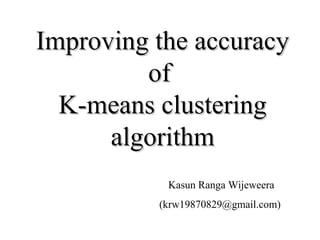Improved k-means
•Descargar como PPT, PDF•
1 recomendación•436 vistas
Denunciar
Compartir
Denunciar
Compartir

Recomendados
Recomendados
Más contenido relacionado
La actualidad más candente
La actualidad más candente (20)
Principal Component Analysis (PCA) and LDA PPT Slides

Principal Component Analysis (PCA) and LDA PPT Slides
Implement principal component analysis (PCA) in python from scratch

Implement principal component analysis (PCA) in python from scratch
PCA (Principal component analysis) Theory and Toolkits

PCA (Principal component analysis) Theory and Toolkits
Principal component analysis - application in finance

Principal component analysis - application in finance
Classifying hot water chemistry: Application of multivariate statistics

Classifying hot water chemistry: Application of multivariate statistics
ICDE-2015 Shortest Path Traversal Optimization and Analysis for Large Graph C...

ICDE-2015 Shortest Path Traversal Optimization and Analysis for Large Graph C...
Similar a Improved k-means
Similar a Improved k-means (20)
The International Journal of Engineering and Science (The IJES)

The International Journal of Engineering and Science (The IJES)
Optimising Data Using K-Means Clustering Algorithm

Optimising Data Using K-Means Clustering Algorithm
A Mathematical Programming Approach for Selection of Variables in Cluster Ana...

A Mathematical Programming Approach for Selection of Variables in Cluster Ana...
Mine Blood Donors Information through Improved K-Means Clustering

Mine Blood Donors Information through Improved K-Means Clustering
Más de Kasun Ranga Wijeweera
Más de Kasun Ranga Wijeweera (20)
Digital Differential Analyzer Line Drawing Algorithm

Digital Differential Analyzer Line Drawing Algorithm
Assignment for Factory Method Design Pattern in C# [ANSWERS]![Assignment for Factory Method Design Pattern in C# [ANSWERS]](data:image/gif;base64,R0lGODlhAQABAIAAAAAAAP///yH5BAEAAAAALAAAAAABAAEAAAIBRAA7)
![Assignment for Factory Method Design Pattern in C# [ANSWERS]](data:image/gif;base64,R0lGODlhAQABAIAAAAAAAP///yH5BAEAAAAALAAAAAABAAEAAAIBRAA7)
Assignment for Factory Method Design Pattern in C# [ANSWERS]
Improved k-means
- 1. Improving the accuracy of K-means clustering algorithm Kasun Ranga Wijeweera (krw19870829@gmail.com)
- 2. This presentation is based on the following research paper K. A. Abdul Nazeer, M. P. Sebastian, Improving the Accuracy and Efficiency of the k-means Clustering Algorithm, Proceedings of the World Congress on Engineering 2009 Vol I, WCE 2009, July 1 – 3, 2009, London, U. K.
- 3. Consider a Set of Data Points, And a Set of Clusters,
- 4. The Goal,
- 5. Algorithm k-means 1.Randomly choose K data items from X as initial centroids. 2.Repeat Assign each data point to the cluster which has the closest centroid. Calculate new cluster centroids. Until the convergence criteria is met.
- 6. K-means gets stuck in a local optima
- 7. Algorithm selection of initial centroids 1. Set m = 1; 2. Compute the distance between each data point and all other data points in the set; 3. Find the closest pair of data points from the set X and form a data point set A[m] (1 <= m <= K) which contains these two data points. Delete these two data points from the set; 4. Find the data point in X that is closest to the data points set. Add it to A[m] and delete it from X; 5. Repeat step 4 until the number of data points in A[m] reaches 0.75*(n/k);
- 8. Algorithm selection of initial centroids continued… 6. If m < k then m = m + 1, find another pair of data points from X between which the distance is the shortest, form another data point set A[m] and delete them from X. Go to step 4; 7. For each data point set A[m] (1 <= m <= K) find the arithmetic mean of the vectors of data points in A[m]. These means will be the initial centroids.
- 10. Thanks for your attention !
